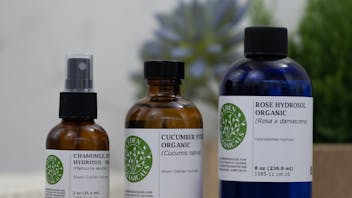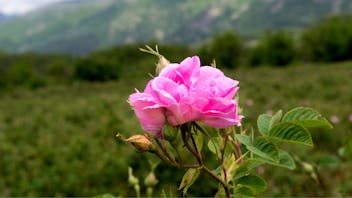Product Overview
Our exquisite Rose Hydrosol is a certified organic, 100% pure and natural product that does not contain any additives, preservatives or synthetic substances. This very special hydrosol, from the producers of our exceptional organic Rose Otto from Bulgaria, contains about 0.10% of Rose essential oil (aka Rose Otto) - a remarkably high percentage - as a result of a second distillation called cohobation. Rose oil lends natural preservative properties and helps keep the hydrosol stable for approximately 18 months from the date of production.[1]
Packaging Note: Sizes 1 oz through 4 oz are packaged in glass bottles. Larger sizes (8 oz and up) are packaged in BPA free plastic bottles due to seasonal factors. Hydrosols can freeze and expand when temperatures drop which can result in bottle breakage. If you are experiencing extreme cold in your area, please contact us to ensure your shipment comes appropriately packaged. Packaging Note: Sizes 1 oz through 4 oz are packaged in glass bottles. Larger sizes (8 oz and up) are packaged in BPA free plastic bottles due to seasonal factors. Hydrosols can freeze and expand when temperatures drop which can result in bottle breakage. If you are experiencing extreme cold in your area, please contact us to ensure your shipment comes appropriately packaged.
Please contact us if you are interested in bulk sizes.
The volatiles consist mainly of 2-phenylethanol, linalool, nerol, and geraniol, along with rose oxides and all other characteristic minor rose compounds. Phenylethanol is an important hydrophilic fragrance constituent that appears in the distillate of roses, but not in the distilled essential oil. It is only through cohobation, the redistillation of the hydrosol, that phenylethanol may be reclaimed.[2]
Strict quality control and the utmost care are taken at each stage of the labor intensive and time sensitive harvest-to-hydrosol production cycle. Once cohobated, the rose distillate (hydrosol) passes through a system of micron filtration, beginning with 1 micron and finishing off with 0.2 micron. This is a particularly effective tool to test for heavy metals including lead that, according to our domestic hydrosol supplier, can be a problem with some of the older European stills. Finally, at the producer's on-site laboratory, samples are taken from each batch of hydrosol to ensure it is stable and sterile.[3]
Among its many uses, Rose Hydrosol’s sublime floral aroma is perfect for refreshing bed linens, room environments, nurseries, and in the car or plane. Its cooling and mildly astringent properties are a gift for mature and sensitive skin. As a facial refresher, it adds and helps retain moisture in dry and aging skin. Rose Hydrosol may be used in masks and steams, in the bath, as a toner, and to moisten skin before application of facial oils. Botanical formulators find use for Rose Hydrosol in body lotions, facial serums, after-shaves, creams, gels and other preparations.
Our hydrosols are distilled using fresh plant material that not only allows capture of all the volatiles, but most importantly, the cellular water from the living plant. It is this cellular water, imbued with nourishing minerals and fatty acids, that make it dynamic and vibrant compared to using dried out material with a resulting loss of those important skin-refreshing and aromatic molecules.[4] Aromatic hydrosols contain the water-soluble active principles of the plant. They retain a tiny amount of essential oil compounds (about 0.2 grams/liter[5]) - mostly the gentler, more hydrophilic aromatic esters and alcohols (like citronellyl acetate and phenylethanol) - and are subsequently unlikely to cause skin irritation.[6]
The gentleness of hydrosols is ideally suited in the delivery of their attributes for children, the elderly, and those with pronounced sensitivities. They are also a profound and delightful way to experience and appreciate the life force - with all its potentiality for wholeness - found in the aromatic waters of the plants.
PLEASE NOTE: The hydrosols we offer are specifically distilled for the hydrosol, not as a co-product or even a by-product. The plant's cellular water and many components – normally lost under pressurized short steam runs for essential oil, or by using dried material – are what the producers specifically distill for by using only fresh plant material right from their farm or from local farms to ensure that the plant material is as fresh as possible.[7]
1 Industry communication.
2 Ibid.
3 Ibid.
4 Ibid.
5 Lavabre, Marcel. Aromatherapy Workbook (revised edition), 1997, p. 26.
6 Ibid.
7 Industry communication.



